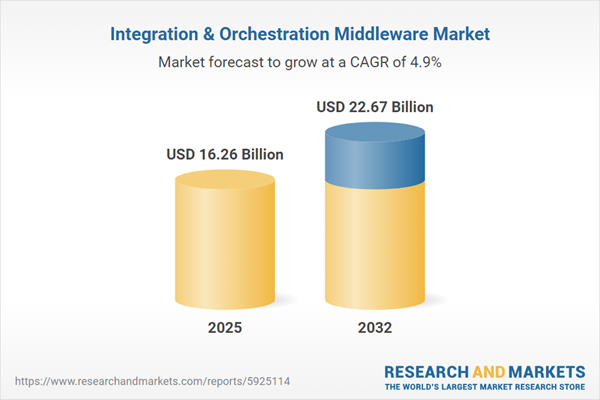Speak directly to the analyst to clarify any post sales queries you may have.
Integration and orchestration middleware is redefining how enterprises connect and manage digital operations. As organizations adapt to rapidly changing technological landscapes, efficient middleware solutions are the backbone for aligning IT ecosystems, ensuring operational flexibility, and supporting strategic business objectives.
Market Snapshot: Integration & Orchestration Middleware Market Overview
The integration and orchestration middleware market is currently valued at USD 15.51 billion, with expectations to reach USD 16.26 billion over the next twelve months. A compound annual growth rate of 4.85% is projected, pointing to a market size of USD 22.67 billion by 2032. Growth drivers include the growing adoption of digital transformation strategies and the accelerated modernization of IT infrastructure. Organizations are rapidly investing in hybrid and cloud-native environments, creating heightened demand for middleware that automates workflows, maintains compliance, and facilitates secure, seamless connectivity across applications and data. In a climate of increasing digitization, robust integration frameworks are pivotal to supporting informed business decisions and scalable, future-ready enterprise operations.
Scope & Segmentation: Integration and Orchestration Middleware Solutions
- Solution Types: API management platforms enable secure data exchange across diverse applications. Enterprise service bus solutions integrate legacy systems with modern digital tools for broader interoperability. ETL tools ensure data transformation consistency. Integration platform as a service (iPaaS) bridges cloud and on-premises assets. Foundational middleware delivers the backbone for secure, large-scale messaging.
- Deployment Modes: Cloud-based middleware solutions are chosen for their elasticity and support for distributed IT operations. On-premises deployments offer greater governance, granular control, and targeted compliance, especially where regional data policies are a priority.
- End User Industries: Financial services focus on secure transactions and regulatory demands. Healthcare relies on unified patient data and workflow efficiency. IT and telecom sectors leverage middleware for automating network management. Manufacturing seeks increased automation, while retail enhances customer experience through centralized systems.
- Organization Sizes: Large enterprises adopt middleware for orchestrating automated, complex processes at scale. Small and medium-sized businesses turn to modular solutions, supporting incremental digital enhancements and operational agility.
- Components: Consulting, integration, and support services ensure smooth adoption. Management and security tools maintain system integrity and oversight, which is crucial for consistent integration performance.
- Geographies Covered: The Americas, Europe, Middle East & Africa, and Asia-Pacific are represented, each exhibiting distinct adoption patterns. Regional digital agendas, compliance criteria, and innovation cycles drive market focus and solution customization.
- Technologies Addressed: Cloud-native architectures and microservices provide adaptability. Containerization ensures flexible deployments across platforms, while event-driven and serverless models boost operational efficiency. Adoption of low-code and no-code platforms speeds up integration. AI and machine learning introduce analytics and intelligent automation to core middleware processes.
Key Takeaways: Strategic Insights for Decision-Makers
- Middleware enables unified management of varied IT environments, giving organizations the flexibility to adapt to changing compliance pressures and evolving business needs.
- Adoption of modular architectures and event-driven designs promotes agile workflows, supporting businesses in capturing new opportunities and streamlining IT complexity.
- Low-code and no-code platforms empower business users by accelerating resolution of operational challenges and reducing the need for technical resources.
- AI-powered middleware supports proactive infrastructure oversight, minimizes operational disruption, and enhances management of IT assets throughout the enterprise.
- Industries with rigorous regulatory standards rely on comprehensive integration to support secure and reliable operations across the technology stack.
- Strategic alliances with technology vendors and targeted acquisitions drive faster integration maturity, helping organizations build stable and responsive digital ecosystems.
Tariff Impact: United States Trade Dynamics
The introduction of new US tariffs scheduled for 2025 is causing operational uncertainty for middleware providers dependent on global hardware supply chains. In response, companies are increasing local manufacturing and diversifying their supplier base to mitigate risk. These shifts are also leading to broader adoption of software-based integration and virtual platforms, advancing flexibility and business continuity despite changing trade conditions.
Methodology & Data Sources
This analysis synthesizes secondary market research, regulatory review, and direct contributions from industry experts. Each finding is independently validated and benchmarked to provide accuracy and relevance for executive decision-making.
Why This Report Matters
- Offers actionable insights tailored for senior leaders considering integration and orchestration middleware investments.
- Structures the complex landscape of integration options, supporting clarity as digital transformation accelerates and regulations evolve.
- Enables alignment of modernization initiatives with organizational strategy, reinforcing resilience and supporting a competitive edge in changing global markets.
Conclusion
Integration and orchestration middleware are foundational to enterprise agility and seamless workflows. This report equips decision-makers with the strategic perspective to guide IT transformation and harness opportunities in an evolving digital environment.
Additional Product Information:
- Purchase of this report includes 1 year online access with quarterly updates.
- This report can be updated on request. Please contact our Customer Experience team using the Ask a Question widget on our website.
Table of Contents
3. Executive Summary
4. Market Overview
7. Cumulative Impact of Artificial Intelligence 2025
Companies Mentioned
The companies profiled in this Integration & Orchestration Middleware market report include:- International Business Machines Corporation
- Oracle Corporation
- Microsoft Corporation
- SAP SE
- MuleSoft, Inc.
- Software AG
- TIBCO Software Inc.
- Red Hat, Inc.
- Informatica LLC
- Dell Boomi, LLC
Table Information
| Report Attribute | Details |
|---|---|
| No. of Pages | 180 |
| Published | October 2025 |
| Forecast Period | 2025 - 2032 |
| Estimated Market Value ( USD | $ 16.26 Billion |
| Forecasted Market Value ( USD | $ 22.67 Billion |
| Compound Annual Growth Rate | 4.8% |
| Regions Covered | Global |
| No. of Companies Mentioned | 11 |









